Questões de Concurso Público IGP-SC 2017 para Perito Criminal Engenharias
Foram encontradas 80 questões
A curva tensão-deformação (σ-ε) mostrada foi obtida a partir de um ensaio de tração realizado em um corpo de prova cilíndrico com diâmetro de 10 mm e comprimento útil de 150 mm, confeccionado de um material metálico. São indicados alguns pontos desta curva (A, B, C, D, E e F) utilizados para se obter determinadas propriedades do material. Com base nestes pontos, assinale a alternativa correta.
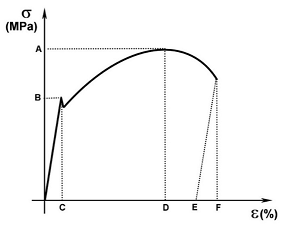
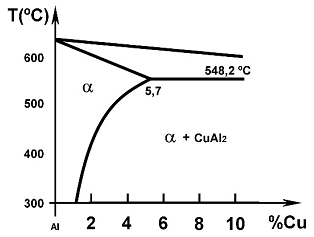
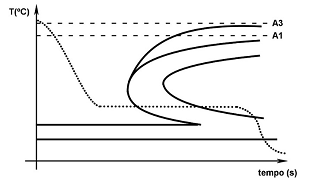
Na figura a seguir é mostrado uma imagem da região fraturada de um aço obtida com o auxílio de um microscópio eletrônico de varredura (MEV) com um aumento de 500x. Esta figura é também conhecida como fractografia e traz uma característica típica que indica o mecanismo de fratura predominante nesta região. Assinale a alternativa que possui a descrição correspondente às suas características e o mecanismo de fratura ocorrido na região apresentada na figura.
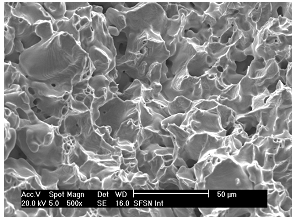
A seguir é mostrada uma micrografia de um aço carbono contendo 0,45 %C (aço ABNT1045). Escolha a alternativa que corresponda corretamente à descrição da microestrutura apresentada na figura.
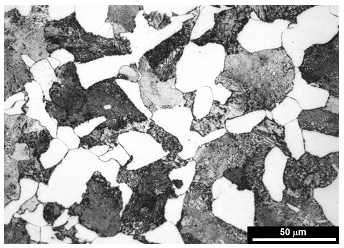
A figura a seguir mostra um diagrama de fase binário Bi-Sb (bismuto-antimônio). Neste diagrama é indicado um ponto “A” que corresponde a uma liga Bi-Sb com 60%Sb a 500 ºC. Considere todas as condições quando o equilíbrio de fases é alcançado e escolha a opção correta.
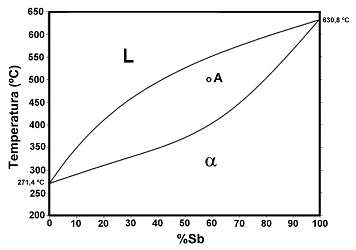
O método de difração de raios X é frequentemente utilizado como técnica complementar de caracterização dos materiais. Assinale a alternativa que melhor corresponda ao difratograma apresentado a seguir.

O policial Ferdinando, ao chegar a um local no qual ocorreu uma tentativa de homicídio, notou que havia uma mulher com um ferimento perfurocortante em seu abdômen e, embora a vítima estivesse perdendo sangue, ainda mostrava sinais de vida. Ferdinando, sem hesitar, entrou no local e levou a vítima ao hospital mais próximo.
Em princípio, baseado no que prevê o artigo 169 do Código de Processo Penal (Para o efeito de exame do local onde houver sido praticada a infração, a autoridade providenciará imediatamente para que não se altere o estado das coisas até a chegada dos peritos, que poderão instruir seus laudos com fotografias, desenhos ou esquemas elucidativos.) e na doutrina consagrada dos procedimentos de isolamento e preservação de local de crime (adotada pela Secretaria Nacional de Segurança Pública, por exemplo), Ferdinando:
Um local de morte, como a própria designação esclarece, é definido como o sítio onde ocorreu a extinção de uma pessoa. Assim, para a elucidação dos fatos que culminaram no evento morte, o perito criminal deve realizar um minucioso levantamento dos vestígios, das posições dos objetos, do cadáver e do próprio ambiente.
Em um local de morte por arma de fogo, por exemplo, o ambiente é vasculhado em toda a sua amplitude, fotografando-se os pontos de impactos de projéteis, se houver. Determina-se, também, a distância, a origem e a direção do disparo, estabelecendo-se, desse modo, a provável trajetória. Em seguida, examina-se o cadáver à procura dos ferimentos, os orifícios de entrada e de saída do projétil, e suas localizações.
Por fim, examinam-se os próprios projéteis e estojos encontrados no local, com o escopo de se fazer a identificação mediata da arma (microcomparação balística) que causou a lesão, caso nenhuma seja encontrada.
Destarte, todos os procedimentos descritos anteriormente para o local de morte por arma de fogo, entendidos como uma diligência processual penal veiculada através do instrumento conhecido como laudo de local, visam determinar a causa jurídica da morte; ou seja, estabelecer a diagnose diferencial entre homicídio, suicídio e acidente.
Baseando-se nos dados citados, podemos classificar os ferimentos produzidos pelo projétil disparado por uma arma de fogo como:
UNEARTHED: REMAINS OF THE EARLIEST KNOWN
TSUNAMI VICTIM
By Charles Choi | October 25, 2017 1:00 pm
Paragraph 1 Tsunamis have claimed hundreds of thousands of lives in the past two decades. Now a new study finds that a 6,000-year-old skull may come from the earliest known victim of these killer waves.
Paragraph 2 The partial human skull was discovered in 1929 buried in a mangrove swamp outside the small town of Aitape Papua New Guinea, about 500 miles north of Australia. Scientists originally thought it belonged to an ancient extinct human species, Homo erectus. However, subsequent research dated it to about 5,000 or 6,000 years in age, suggesting that it instead belonged to a modern human.
A Rare Specimen
Paragraph 3 The skull is one of just two examples of ancient human remains found in Papua New Guinea after more than a century of work there. As such, archaeologists wanted to learn more about this skull to elucidate how people settled this region.
Paragraph 4 The scientists went back to where this skull was found and sampled the soil in which it was discovered. They focused on details such as sediment grain size and composition.
Paragraph 5 In the sediment, the researchers discovered a range of microscopic organisms from the ocean known as diatoms. These were similar to ones found in the soil after a 1998 tsunami killed more than 2,000 people in Papua New Guinea — for instance, their shells of silica were broken, likely by extremely powerful forces.
Paragraph 6 These diatom shells, combined with the chemical compositions and the size ranges of the grains, all suggest that a tsunami occurred when the skull was buried. The researchers suggested the catastrophe either directly killed the person or ripped open their grave.
Paragraph 7 Tsunamis, which are giant waves caused by earthquakes, volcanic eruptions or underwater landslides, are some of the deadliest natural disasters known. The 2004 tsunami in the Indian Ocean killed more than 230,000 people, a higher death toll than any fire or hurricane.
Paragraph 8 The site where the skull was found is currently about 7.5 miles away from the coast. Still, the researchers noted that back when whoever the skull belonged to was alive, sea levels were higher, and the area would have been just behind the shoreline.
Paragraph 9 The waves of the tsunami that hit Papua New Guinea in 1998 reached more than 50 feet high and penetrated up to three miles inland. “If the event we have identified resulted from a similar process, it could have also resulted in extremely high waves,” study co-lead author Mark Golitko, an archaeologist at the University of Notre Dame in Indiana and the Field Museum in Chicago.
Paragraph 10 These results show “that coastal populations have been vulnerable to such events for thousands of years,” Golitko said. “People have managed to live with such unpredictable and destructive occurrences, but it highlights how vulnerable people living near the sea can be. Given the far larger populations that live along coastlines today, the potential impacts are far more severe now.”
Paragraph 11 Golitko plans to return to the area over the next few years “to further study the frequency of such events, how the environment changed over time, and how people have coped with the environmental challenges of living in that environment.” He and his colleagues detailed their findings Wednesday in the journal PLOS O.
Retrieved and adapted from:
<http://blogs.discovermagazine.com/d-brief/2017/10/25/first-tsunami-victim/#.WfYiYmhSzIU>
UNEARTHED: REMAINS OF THE EARLIEST KNOWN TSUNAMI VICTIM
By Charles Choi | October 25, 2017 1:00 pm
Paragraph 1 Tsunamis have claimed hundreds of thousands of lives in the past two decades. Now a new study finds that a 6,000-year-old skull may come from the earliest known victim of these killer waves.
Paragraph 2 The partial human skull was discovered in 1929 buried in a mangrove swamp outside the small town of Aitape Papua New Guinea, about 500 miles north of Australia. Scientists originally thought it belonged to an ancient extinct human species, Homo erectus. However, subsequent research dated it to about 5,000 or 6,000 years in age, suggesting that it instead belonged to a modern human.
A Rare Specimen
Paragraph 3 The skull is one of just two examples of ancient human remains found in Papua New Guinea after more than a century of work there. As such, archaeologists wanted to learn more about this skull to elucidate how people settled this region.
Paragraph 4 The scientists went back to where this skull was found and sampled the soil in which it was discovered. They focused on details such as sediment grain size and composition.
Paragraph 5 In the sediment, the researchers discovered a range of microscopic organisms from the ocean known as diatoms. These were similar to ones found in the soil after a 1998 tsunami killed more than 2,000 people in Papua New Guinea — for instance, their shells of silica were broken, likely by extremely powerful forces.
Paragraph 6 These diatom shells, combined with the chemical compositions and the size ranges of the grains, all suggest that a tsunami occurred when the skull was buried. The researchers suggested the catastrophe either directly killed the person or ripped open their grave.
Paragraph 7 Tsunamis, which are giant waves caused by earthquakes, volcanic eruptions or underwater landslides, are some of the deadliest natural disasters known. The 2004 tsunami in the Indian Ocean killed more than 230,000 people, a higher death toll than any fire or hurricane.
Paragraph 8 The site where the skull was found is currently about 7.5 miles away from the coast. Still, the researchers noted that back when whoever the skull belonged to was alive, sea levels were higher, and the area would have been just behind the shoreline.
Paragraph 9 The waves of the tsunami that hit Papua New Guinea in 1998 reached more than 50 feet high and penetrated up to three miles inland. “If the event we have identified resulted from a similar process, it could have also resulted in extremely high waves,” study co-lead author Mark Golitko, an archaeologist at the University of Notre Dame in Indiana and the Field Museum in Chicago.
Paragraph 10 These results show “that coastal populations have been vulnerable to such events for thousands of years,” Golitko said. “People have managed to live with such unpredictable and destructive occurrences, but it highlights how vulnerable people living near the sea can be. Given the far larger populations that live along coastlines today, the potential impacts are far more severe now.”
Paragraph 11 Golitko plans to return to the area over the next few years “to further study the frequency of such events, how the environment changed over time, and how people have coped with the environmental challenges of living in that environment.” He and his colleagues detailed their findings Wednesday in the journal PLOS O.
Retrieved and adapted from:
<http://blogs.discovermagazine.com/d-brief/2017/10/25/firsttsunami-victim/#.WfYiYmhSzIU>